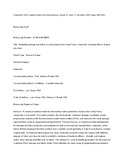JavaScript is disabled for your browser. Some features of this site may not work without it.
| dc.contributor.author | Greve, L. | |
| dc.contributor.author | Pickett, Anthony K. | |
| dc.date.accessioned | 2006-12-12T15:54:35Z | |
| dc.date.available | 2006-12-12T15:54:35Z | |
| dc.date.issued | 2006-11 | |
| dc.identifier.citation | Greve L, Pickett AK. (2006) Modelling damage and failure in carbon/epoxy non-crimp fabric composites including effects of fabric pre-shear. Composites Part A: Applied Science and Manufacturing, Volume 37, Issue 11, November 2006, pp. 1983-2001 | en |
| dc.identifier.issn | 1359-835X | |
| dc.identifier.uri | http://hdl.handle.net/1826/1351 | |
| dc.identifier.uri | http://dx.doi.org/10.1016/j.compositesa.2005.12.012 | |
| dc.description.abstract | A numerical material model for intra-laminar failure prediction of biaxial non-crimp fabric composites is presented. The model combines the elasto-plastic continuum damage constitutive model proposed by Ladevèze with the intra-laminar matrix failure model of Puck, and improves the shear damage representation using an exponential damage function. The work focuses on numerical model development for damage and failure prediction and validation for both unsheared and sheared fabric composites which will result from draping of the fabric preform over a double curved geometry in order to manufacture complex shaped parts. An extensive test program has been conducted using flat composite coupons with differing degrees of fabric pre-shear in order to establish a database of material stiffness, strength, and in-plane matrix shear damage evolution prior to failure. This database is used to identify parameters for the proposed ‘Ladevèze-Puck’ damage and failure model. Final validation has been made by implementing the model in an explicit Finite Element code and performing a series of experimental and simulation analyses on transversely loaded circular composite discs having differing degrees of fabric pre-shear. The model has been shown to successfully capture intra-ply failure modes in the principle fibre directions for tension and compression, intra-ply shear and also the interaction of these modes. | en |
| dc.format.extent | 2092381 bytes | |
| dc.format.mimetype | application/pdf | |
| dc.language.iso | en | en |
| dc.publisher | Elsevier | en |
| dc.subject | Polymer-matrix composites (PMC’s) | en |
| dc.subject | Strength | en |
| dc.subject | Computational modelling | en |
| dc.subject | Mechanical testing | en |
| dc.title | Modelling damage and failure in carbon/epoxy non-crimp fabric composites including effects of fabric pre-shear | en |
| dc.type | Article | en |
Files in this item
This item appears in the following Collection(s)
-
Staff publications (SAS) [907]
